8 Different Types of Toilet Flush Systems-Which is the Best?
Last Updated on August 8, 2023 by toilethaven
Flush toilets have been around since the first time they were introduced by Sir John Harington in 1596. The design, efficiency, and flushing systems have tremendously improved from then to the modern toilets we have today.
Each of the major toilet manufacturers (Toto, Kohler, and American Standard) have designed flushing systems that have made toilets use less water yet have a powerful flush.
Most of the toilets, however, use the gravity flush system only that they twitch it a little to improve the toilet performance. These improvements include having a bigger flush valve and a toilet trap.
The following are the different types of toilet flushing systems:
- Gravity flush system
- Pressure-assisted flush system
- Dual flush system
- Single flush system
- Double-cyclone flush system
- Tornado flush system
- Tower-style flush system
- Double vortex flush system
To understand these flushing systems better, let us first look at how a toilet works.
How a Toilet Works
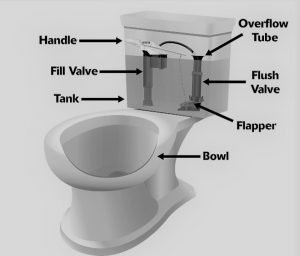
A toilet has two major parts: the tank and the bowl. The tank is installed on top of the bowl to help the water flow downwards from the tank to the bowl via gravity.
The toilet bowl is mounted on top of the drainpipe using bolts and anchored firmly on the floor with the help of a toilet flange. A wax ring is sandwiched between the toilet and the flange to create an airtight and watertight seal.
When you push the toilet, handle down during flushing, a chain connected to the handle lifts off the toilet flapper from the flush valve opening. Water flows from the tank to the bowl via the flush valve.
After releasing the handle, the flapper seals the flush valve allowing the tank to refill in readiness for the next flush. The toilet fills valve refills the tank.
When the water enters the bowl, it exerts a force inside the bowl, therefore, creating a siphon effect at the toilet trap. As a result, the waste in the bowl is sucked into the drainpipe.
A toilet trap is an S-shaped bend at the bottom of the toilet. Apart from creating the suction effect, it also traps toilet clogs and also helps to hold some water at the bottom of the bowl. This water acts as a barrier to sewer smells. More on that here.

Types of Toilet Flushing Systems
A toilet flushing system is of the most important features you should check out while buying a new toilet. If you need a powerful flushing, clog-free toilet, you will need to choose a toilet with a flushing system that is designed for bulk-flushing.
The following are the different types of flushing systems:
1. Gravity Flush System
A gravity-flush toilet system is the most common type of flushing system. All other flushing systems borrow heavily from it. It uses the natural force of gravity to flush a toilet.
Water flows from the tank, which is mounted on top of the bowl, and moves to the bowl via gravity, creating a force inside the bowl that causes the toilet trap to siphon out the waste.
When the water fills the bowl, the pressure inside the bowl becomes higher than the pressure in the trap and drainpipe. As a result, the water and the waste are sucked into the drainpipe and down to the sewer lines.
2. Pressure-Assisted Flushing System
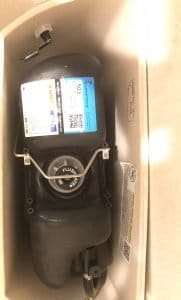
A pressure-assisted toilet flush system combines the gravity flushing system with compressed air. This system is used to create a powerful flush in toilets where a gravity flush system on its own would not be sufficient, like in rear-discharge and upflush toilets.
A pressure-assisted toilet has a secondary plastic tank inside the main tank called a pressure vessel. Incoming water from the water supply line mixes with the air in the pressure vessel, therefore, becoming pressurized.
When you flush the toilet, the water leaves the tank forcefully and powerfully flushes the toilet. Pressure-assisted flushing systems are louder than gravity flush systems which might be uncomfortable for some people.
3. Dual Flush System
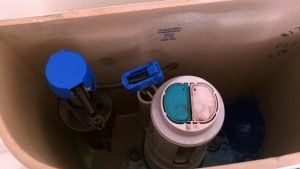
A dual flush system is a system whereby the toilet has 2 options for the amount of water to be used. One is for flushing using a small amount of water, mostly liquids, and another uses more water to flush solids.
Dual flush toilets use flush buttons normally installed at the top of the tank lid, although some use trip levers.
Inside the toilet tank, a dual flush valve assembly is mounted on top of the flush valve. When you press any of the buttons, the valve seal lifts off, allowing water to flow down to the bowl. The amount of water used depends on the button you press down.
To read more on dual flush toilets, their pros and cons, as well as the best models to buy, check out this post.
4. Single Flush System
In a single flush system, the toilet user can only use the same amount of water, whether flushing liquids or solids. These toilet systems mostly use a trip lever handle mounted on the tank’s side or front.
The toilet handle is connected to a lift chain which is in turn connected to a flapper. When you push the toilet handle down, the chain lifts the flapper off the flush valve opening allowing water to flow down to the bowl for flushing to happen.
Most toilets combine a gravity flush system and a single flush system. With the introduction of low-flow toilets, it is possible to find a single flush system toilet that is also water economical
5. Double-Cyclone Flush System
The double-cyclone flush system was designed by Toto and is used in most of their toilets. Water flowing from the tank enters the bowl through 2 nozzles located at the top of the bowl facing sideways.
As a result, the water swirls in the bowl like a cyclone, which effectively cleans, rinses, and flushes the toilet.
Remember, the cyclone is created due to the direction in which the water enters the bowl. The nozzles, which face sideways, allow the water to strike the bowl’s surface, thereby creating a vortex that cleans the bowl.
6. Tornado Flush System
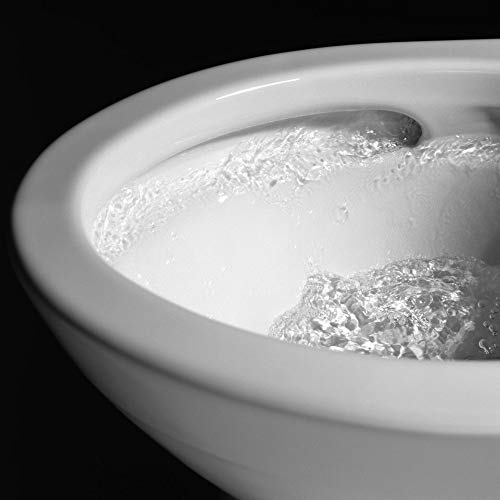
The new Toto toilets use the tornado flush system and are an improved version of the double-cyclone flush system. Instead of 2 nozzles, the tornado flush system lets the water into the bowl through 3 jets positioned sideways around the top of the bowl.
As the water enters the bowl, it violently swirls around the like a tornado which is very effective in cleaning the bowl. It also has a more quiet flush.
With a tornado flush system, the toilet bowl does have a rim that eliminates the breeding ground for germs. It is also easier to clean.
Note! Two other flushing systems designed by Toto tend to confuse homeowners. These are the Toto G-max and Toto E-max flushing systems.
So, what is the difference between the Toto G-max and Toto E-max flushing systems?
The difference between Toto G-max and E-max flushing systems is that toilets using the G-max flushing system use 1.6 gallons of water per flush, while those with the E-max flushing system use 1.28 gallons per flush.
I have written a detailed review of the best Toto toilets in the market. Read it here.
7. Tower-Style Flush System
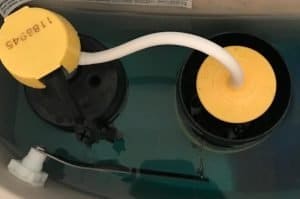
The tower-style flushing system, which is also known as a canister flush system, is mostly used by Kohler toilets. This system uses a canister toilet flapper, which is normally mounted in the middle of the tank and connected to the flush handle.
Unlike a flapper-type flush system, a tower-style flushing system lifts off completely, allowing water to flow from the tank to the bowl from a 360 degrees angle. Therefore, the water can enter the bowl faster, creating a stronger flush.
Kohler’s Class Five flushing technology, which uses a tower-style flushing system, has designed the flush valve in such a way that the entry is larger than the exit in a ratio of 3:2. This design helps to move more water which then builds up pressure and in return a powerful flush.
Read more about the best Kohler toilets here.
8. Double-Vortex Flush System
American Standard’s toilets use the double-vortex flush system. Water enters the bowl via 2 nozzles at the top of the bowl, which faces sideways and creates a whirlpool in the bowl.
Although most of the water comes through the 2 nozzles, some of the water is directed straight to the trapway simultaneously with the double-vortex action.
New American Standards combine the double-vortex flush system with a bigger flush valve to create an even more powerful flush. An example of this is the American Standard Champion 4, which has a 4-inch flush valve.